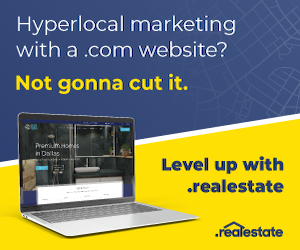10 Tools to Take Your Real Estate Videos to the Next Level
Want to reach more people online? Consider integrating video marketing into your outreach strategy. According to research, people watch an average of 17 hours of online video per week — and they're 52% more likely to share videos than other types of content.
But if the response to your content has been lackluster (or if you're just getting started), take a look at the production quality of your videos. Is your lighting poor? Is your audio tinny? Low production values may be preventing your audience from sharing your clips.
Fortunately, these things can be fixed with simple equipment upgrades. In the video below, Jimmy Burgess, CEO of BHHS Beach Properties of Florida, shares the equipment his firm uses to produce top-tier video content. Watch it to learn:
Basic and advanced methods for shooting videos
Effective lighting setups using a window, box light, and ring light
The importance of audio quality and equipment, plus an overview of various microphones
The difference between shooting with an iPhone vs. professional equipment
Tips and tricks for using your iPhone to create quality video
And more!
Recommended Tools and Equipment
If you're intimidated by all this talk of technical equipment, don't be. Burgess encourages starting with what you have and gradually upgrading — and he says that your phone can still be a great tool in your production efforts. All you need is some extra equipment to help you out.
Below, you'll find a list of the equipment that Burgess suggests for creating high-quality real estate videos.
Lighting
10-inch Ring Light
18-inch Ring Light
Soft Box Light
Audio
Lavalier Mic for iPhone
Wireless Rode Go Mic
Shure SM7B with Podcast Mic Stand
Audio Interface
Camera
Camera Tripod
Camera: Sony A7S3
24-70mm Sigma Lens
Related Reading
How to Create Video CMAs that Connect and Convert
2 Apps for Editing Real Estate Videos Quickly
YouTube Marketing: Fresh Ideas From Real Estate Influencers
MORE >
Listing Photos Your Smartphone Can't Take
Mobile phones today have fantastic built-in cameras. The advancement of camera technology in mobile phones overall has been astounding. They can automatically adjust for contrast, saturation, skin tone, and even background blur to add extra dimension. Moreover, when it comes to dynamic range, the advancement of digital camera technology now can see things we can't see with human eyes.
Smartphone cameras and auto-editing software are so impressive that it can seem like their photos look as good, if not sometimes better, than those taken with a DSLR (digital single-lens reflect) camera.
Because smartphone cameras are so powerful and deliver such beautiful pictures, some agents are forgoing hiring a professional photographer to shoot their listing photos. However, there are many listing photos your smartphone can't take.
Still, despite all the significant advancements – including the use of Artificial Intelligence to enhance smartphone photography – mobile phones can't capture everything that cameras used by professional photographers can. As a result, DSLR – digital single-lens reflex – remains the image champion for real estate listing photos.
Here are a few examples where professional cameras exceed the capabilities of even the most intelligent smartphone with the most advanced camera:
Full-Frame sensors
Smartphones have tiny sensors. With this technology, size matters.
The leading standard for DSLR cameras is full frame (or 35mm). Additionally, the sensor is one of the most expensive technologies in a camera. The larger the sensor, the greater its cost. For example, one of the most popular DSLR cameras for real estate, the Canon 5D Mark IV, has a sensor measuring approximately 36mm x 24mm.
The sensor on a smartphone is around 9mm x 6mm. The result: smaller sensors have a narrower field of view than larger sensors when using lenses of the same focal length.
The disparity of crop sensors physically limits the ability to get the right listing photo shot both inside and outside.
Auto HDR vs. Bracketing
One of the techniques a professional photographer uses is called bracketing. Bracketing means shooting the same image with different camera settings. The result is multiple variations of the same photo to choose from – or even combine – get that perfect shot. One of the most common type of bracketing is exposure bracketing, taking the same shot with at least three different exposure settings.
A DSLR camera offers manual bracketing, giving far more control over what the final results of what the image will look like. Cell phones are limited to auto HDR in camera, often exporting a JPG image. With bracketing, the photographer can set each exposure exactly for each specific situation, often crucial for real estate listing photos.
Clarity
Smartphones, because of their smaller sensors, can't achieve the exact definition and clarity that a DSLR camera can achieve. A great comparison is old school. Think of the difference between an 8 x 10 photo created from a smaller negative versus a larger one. The image would be blurry when enlarged from the smaller negative yet crystal clear when made with the larger negative.
For the sharpest images, smartphones can't compete. That is the last thing you want when someone is surfing the web looking for homes on their high-resolution screens and seeing anything but crystal-clear images.
Photos on a cloudy day
You can't control the weather. So, when it comes to shooting photos on a cloudy day, smartphones struggle. However, because you can manually adjust DSLR cameras to the correct settings, the photographer can dial in the correct levels for sensitivity, exposure, and aperture.
When you take that same shot with your smartphone, you trust its computer to do the work in terms of setting the shutter speed, white balance, and the right parts of the image to expose.
That's why cloudy day photos, for example, that you take with your smartphone, are no match for those taken by a professional photographer with their DSLR camera.
Distance
Have you been on a walk, seen a deer in the distance or a fascinating bird, and whipped out your smartphone to take a shot? It looks crystal clear on your screen, right? So you take the picture, but it is significantly blurred when you look at it closely after the shot.
Think of shooting a house in the same way, from the same distance. Again, when it comes to professionally shot photos, clarity is vital. While a picture may look good on your smartphone, how does it fair on a 32" 4K computer monitor that a prospective home buyer is using to view it?
Even the best phones with long-range cameras use digital zoom versus "real" optical zoom.
That's why DSLR cameras excel when it comes to distance shots.
Lens selection
Another massive advantage that DSLR cameras have over a smartphone is lens selection. Smartphones have a lens equivalent to 28mm on a DSLR camera. Some can even mimic a 50mm field of vision used for portrait photography. And some lenses can be attached to your smartphone to enhance its shooting capabilities.
But lens selection for mobile phones is limited and pales compared to the hundreds of lenses available for DSLR cameras. Moreover, lenses give DSLR cameras advantages for almost every kind of photo: long distance shots, wide angle, perspective shots, and more are possible simply by switching out a lens.
Post-production
Smartphone editing software is super slick these days, built in for easy use and making pretty good photos look even better. But what a photographer can do with RAW files from a DSLR camera plus advanced photo editing software like Lightroom and Photoshop makes their excellent work exceptional. When it comes to post-production advantages, the images that a DSLR camera takes begin with an edge over those taken by a smartphone. Then, add the skills that a professional photographer brings to the post-production process. Once again, DSLR photos are far superior to listing photos taken with a mobile phone.
The eye of a photographer
Beyond the image capabilities and comparisons between what a DSLR camera and a camera on a smartphone can take, the X-factor is the photographer. Professional real estate photographers use DSLR cameras for a reason: it is what they need to get the best listing photos.
How a professional real estate photographer "sees" how to line up a shot and find the right angle or perspective is often learned from years of taking hundreds of real estate photos. There's no contest when you add the value of having a professional with the right equipment shoot your listing photos.
The right tool
DSLR or mirrorless cameras are not software dependent for exceptional imagery. They use big sensors, big lenses, and big grips and tripods that hold these cameras steady to capture the best photos. The images shot with a DSLR camera still can't be matched by any smartphone.
The bottom line: DIY with your smartphone is like using the wrong tool from your toolbox when it comes to listing photos. You hire a professional photographer for their exceptional skills and because they use the proper tool.
Joe Jesuele is the founder and CEO of HomeJab, America's most popular and reliable on-demand professional real estate photography and video marketplace for real estate pros and architect of the real NFT Marketplace at real.art. HomeJab delivers over 4,000,000 images to help agents sell and rent more than $35 billion in listings.
MORE >
How Drones Can Help Drive Interest in Today's Real Estate World
As with so many of the unique challenges in the COVID-19 real estate world, technology is helping to bridge the gaps and allow buyers to fall in love with homes from a distance. Aerial drones filled a valuable niche in real estate marketing even before the pandemic, but their use has only grown more prominent during the last year. With creative use of drone footage, you can help buyers fall in love and help sellers show off their properties from a whole new perspective.
Why Drones Truly Took Off in Real Estate in 2020
The challenges posed by COVID-19 and precautions in place to prevent its spread have impacted every part of life, including real estate. Many markets have restrictions currently in place that make touring homes and neighborhoods in person impractical. And while there are some more "open" communities around the country, many real estate clients won't be comfortable making tours in person. Virtual tours and online research have taken an even more important role in buying a new home than ever before, with drones providing valuable footage that simply can't be obtained in any other way.
How Buyers Are Adapting to Shopping in the COVID-19 Era
The good news is that even with all of the unique challenges we have faced recently, buyers are still very interested in purchasing homes and sellers still want to find the right buyer for their properties. Today, buyers rely on virtual tours for learning about the homes and neighborhoods that pique their interest. They are looking for detailed footage that really helps them fall in love with a home and neighborhood. This includes all of the photos/video that you're already used to gathering from ground level, but a view from above can really help tie the whole package together. That's where aerial drones enter the picture.
Normal Home Footage Is Great, But It Has Some Key Limitations
With a high-quality smartphone equipped with the right apps and accessories, you can capture great footage of a home from ground level. Drones don't replace that footage, but perspective and scale are also limited when capturing footage from the ground. You can show off individual rooms or provide an impression of how the home looks from the curb, but there's no way to get a holistic view of the property from the ground. So by all means keep creating those great, detailed virtual tours with your phone, but don't forget to include a view from above.
Drones Provide a Unique Perspective That Can't Be Captured Any Other Way
When you're trying to capture everything that a property has to offer, there's simply no substitute for the unique perspective that drone footage provides. It shows how the whole property fits together, and how it has been maintained. If the home is situated in an area with beautiful, natural views, aerial footage can perfectly show off that natural landscape around the home. If it's in a more densely populated, urban community, then a view from above shows how the home fits into the neighborhood.
Helping Buyers Fall in Love with Neighborhoods Is More Important than Ever
Savvy buyers know that they're shopping for a neighborhood just as much as they're shopping for a home, and that hasn't changed in the COVID-19 era. Of course, how buyers connect with those neighborhoods has changed a great deal. Traveling to visit a potential new neighborhood is challenging, and in many markets the buyer won't be able to see much even if they did make a trip. But they still want to get a feel for the neighborhood, find how close key services will be located, see what they'll do for fun, and discover how their potential new home is situated within the larger community. Drones and aerial views can help put that all in perspective.
How Drones Can Help Capture the Essence of Each Neighborhood
While virtual tours work great for homes, they are much more difficult to pull off when you're trying to showcase an entire neighborhood. Even if you get great footage of a few local businesses and attractions, it's hard to show how everything is connected within the neighborhood. An aerial view of the community provides a completely different perspective, allowing buyers to see how they'll move through the neighborhood, imagine what their daily routine would be like, and discover what they'll do for fun. For a home located in a rural area or deep in nature, an aerial view will highlight the privacy of the space and the natural beauty of the surrounding area.
Drone Footage Is as Valuable for Sellers as It Is for Buyers
We have talked plenty about how drone footage can help buyers fall in love with homes and communities, but the other side of that coin is just as important. When you're selling a property for a client, you want them to know that you're doing everything possible to market their home and overcome the challenges posed by the COVID-19 era. Providing drone footage – in addition to new standbys like virtual tours – shows sellers that you will leave no stone unturned when it comes to marketing their home. A commitment to using the best marketing tools available is great for helping sellers find buyers, and for earning referrals from satisfied sellers once the deal is closed.
Getting Started with Drones Is Easier than You Might Think
Becoming an expert with drone photography/video takes practice and time, but it's not too difficult to get started. Just remember that before you film with a drone, especially in public, you'll want to check out local regulations for drone use. The first thing you will need is a drone, and there are entry level models with basic cameras, often available for less than $100, that are great for practicing. More advanced models – which you'll eventually want for capturing pro-quality footage – start at around $500 and rise from there. If you wish to use your own camera, you can also purchase a drone capable of carrying cameras of any size. Once you have the equipment, it's just a matter of practicing, reviewing your footage, and getting comfortable with the process.
When challenges arise, the most adaptable industries discover new ways to get things done. The real estate world has adapted in so many ways to COVID-19, and many of those adaptations will continue to provide value even when things return to normal. Drone footage is an excellent way to show off your listings/ markets now, and should remain a valuable tool well into the future.
To view the original article, visit the Delta Media Group blog.
MORE >
Top 5 Beginner Camera Tips for Real Estate Photography
Starting off in real estate photography? Not sure where to begin? We're here to help! This article will explore five practical tips for anyone starting off in real estate photography that will help speed up your workflow and improve image quality.
MORE >
Real Estate Property Photos: Property Photography 101
Whether it's services or goods, an aesthetically pleasing picture will attract more eyes and drive more leads. Real estate property photos are no exception to this rule.
If you're starting out and don't want to invest in a professional real estate photographer, or are looking to cut some costs, we've put together a beginner's guide you can use to create compelling real estate photos for your own listings. With this guide and practice, you can create better listing photos that will grab the most eyes!
MORE >
Best Real Estate Camera?
What is the best camera out there for real estate?
That is the most popular question I get while traveling across the country and on the Tech Savvy Agent Facebook page.
The boring answer is....there isn't a single camera that is best suited for real estate. Cameras evolve so quickly, new models appear yearly, and everyone has a different level of photographic skill.
However, I know you guys still want some type of direction for your budget, and that is the key word here--budget. When people ask me to recommend a "good" option, my price range for a "decent" kit starts at around $1500. Does that make it the only price range you should look in? No, for most agents that investment simply isn't feasible, or some agents have the budget to go much higher!
I created a video tutorial that might help you with this question. No, I don't tell you what camera to buy. Instead, this video covers what to look for in a camera that will be used for real estate purposes. It doesn't matter if you want to spend $500 or $5000 dollars. It's important to have a basic understanding of each specification and what it means to you and your final images.
MORE >
5 Easy Ways to Integrate Video into Your Marketing Efforts
Guest Contributor Veneeta Eason says:
Real estate professionals know that success is, in part, driven by how well they can create a connection. One way to do that is to integrate video into your marketing campaign. With today’s technology, it is easier than ever to capture great video. What previously required a studio, a green screen and professional media equipment can now be done with a handheld video camera and a computer.
More importantly, video has the ability to increase your business, build better relationships and amplify your credibility. Here are five easy ways to integrate video into your marketing efforts:
MORE >
How to Select a Good Point and Shoot Camera
Recently, Kodak partnered with REALTOR® Magazine to present a nationwide “Listing through a Lens” webinar on taking good pictures. This webinar covered many aspects of photography and serves as an excellent reference for agents who are looking to improve the photo quality of the listings they market.
While there are many considerations for what makes a good camera, with today’s modern cameras and technology, it is possible for an agent to take a great picture using a point and shoot that has a great lens. This series of articles will provide real estate agents with valuable information on the types of equipment they need, and feature expert content to help maximize your listing photos.
In this article, we are pleased to provide some of the features you would want to look for in a “point-and-shoot” digital camera to get the most out of your listings.
MORE >









